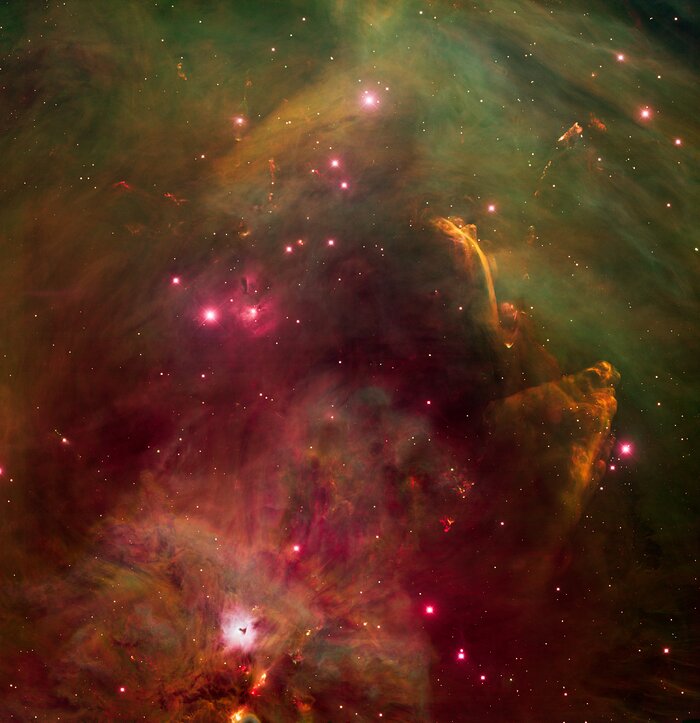Reflection Nebula NGC 1999
This wide-field panorama of star formation was captured with the National Science Foundation’s Mayall 4-meter telescope on Kitt Peak. Located in the constellation of Orion (the Hunter), the image show a portion of one of Orion’s giant molecular clouds (known as “Orion A”) where new stars are forming. The bright object in the bottom-left corner is the reflection nebula NGC 1999, which contains the young star V380 Orionis. A small, triangle shaped patch of dusty material is seen in silhouette against the reflection nebula. NGC 1999 lies at the center of a network of nebulous filaments which billow out and away like the spokes of a bicycle wheel.
Powerful jets of gas are often the first visible manifestations of the birth of young stars. These jets punch holes through the opaque clouds in which the star is formed, holes through which the light of the new-born stars can escape to produce what are known as reflection nebulae. Several such nebulae are seen in this image. Outflowing jets from young stars also power luminous shock waves known as Herbig-Haro (HH) objects, which move through the surrounding gas at speeds of up to hundreds of kilometers per second (over 100,000 miles an hour). As these shock waves ram their surroundings, they heat up bow-shaped nebulae of glowing plasma. This image shows dozens of such objects.
The region below NGC 1999 reflection nebula contains a cluster of deeply embedded young stars. These objects were first recognized by Guillermo Haro and George Herbig around 1950 and today they are known as HH 1 and HH 2. Recent observations indicate that the cone shape located near the right edge of the image (known as HH 401) may be a giant bow shock powered by the source of the HH 1 & 2 outflow. If so, this outflow is more than 10 light-years long! The arc of light which looks like a waterfall (located above and to the right of the center of the image) is the enigmatic object HH 222. Unlike most other HH objects, it is a source of polarized, non-thermal radio waves. The nature of this feature remains largely unknown. From the upper-right to the lower-right of the image runs a long chain of Herbig-Haro objects associated with the object HH 34. HH 34 itself is the bright and compact bow shock located near the bottom of HH 222. Just above HH 34, a compact jet can be seen to emerge from the source star, which is not visible in this image. This jet and its first bow shock (HH 34) mark the inner portion of a chain of shocks which trace a graceful S-shaped curve from the upper right hand corner of the image down towards HH 1 & 2. The north end of the flow is just below the top of the image (objects HH 33 & 40); the south end of the flow terminates in a group of small bow shocks known as HH 86 & 87, which reside in the dark region between HH 401 and NGC 1999. This image was used as the gorund-based image in Hubble News Release Number: STScI-2011-20. Many other smaller nebulous patches in this image mark small reflection nebulae, Herbig-Haro objects, and stellar jets. The rich detail in this image reveals one of the most fascinating areas of the night sky.
Credit:Z. Levay (STScI/AURA/NASA), T.A. Rector (University of Alaska Anchorage) and H. Schweiker (NOIRLab/NSF/AURA)
About the Image
| Id: | noao1104a |
| Type: | Observation |
| Release date: | Aug. 31, 2011 |
| Related releases: | noao1104 |
| Size: | 8027 x 8291 px |
About the Object
Image Formats
Wallpapers
Coordinates
| Position (RA): | 5 35 49.82 |
| Position (Dec): | -6° 30' 26.25" |
| Field of view: | 34.68 x 35.97 arcminutes |
| Orientation: | North is 179.9° left of vertical |
Colors & filters
| Band | Tele-scope |
|---|---|
| Nicholas U. Mayall 4-meter Telescope |

